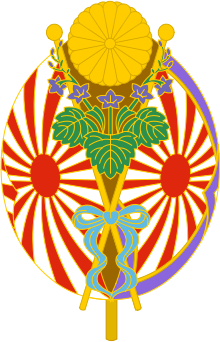- Gensui (Imperial Japanese Army)
-
Marshal (元帥 Gensui) (also frequently translated as Field marshal) was the highest title in the prewar Imperial Japanese Military.
The term gensui, which was used for both the Imperial Japanese Army and the Imperial Japanese Navy, was at first a rank held by Saigō Takamori as the Commander of the Armies in 1872. However in May 1873 Saigō was 'demoted' to General, with gensui thereafter no longer a rank as such, but a largely honorific title awarded for extremely meritorious service to the Emperor - thus similar in concept to the French title of Marshal of France.
While gensui would retain their actual ranks of general or admiral, they were entitled to wear an additional enamelled breast badge, depicting paulownia leaves between crossed army colour and naval ensign under the Imperial Seal of Japan. They were also entitled to wear a special samurai sword of a modern design on ceremonial occasions.
In the Meiji period, the title was awarded to 5 generals and 3 admirals. In the Taishō period it was awarded to 6 generals and 6 admirals, and in the Shōwa period it was awarded to 6 generals and 4 admirals. The higher title of Dai Gensui was comparable to the title of Generalissimo.
Note that several were promoted the same year they died - these were posthumous promotions.
Field Marshal Name (Birth-Death) From X July 19, 1872 Saigō Takamori (1827-1877) Kagoshima 1 January 20, 1898 Prince Yamagata Aritomo (1838-1922) Yamaguchi 2 January 20, 1898 Prince Komatsu Akihito (1846-1903) Imperial Family 3 January 20, 1898 Prince Ōyama Iwao (1842-1916) Kagoshima 4 January 31, 1906 Marquis Nozu Michitsura (1840-1908) Kagoshima 5 October 24, 1911 Count Oku Yasukata (1847-1930) Fukuoka 6 January 9, 1914 Count Hasegawa Yoshimichi (1850-1924) Yamaguchi 7 January 9, 1914 Prince Fushimi Sadanaru (1858-1923) Imperial Family 8 January 9, 1914 Baron Kawamura Kageaki (1850-1926) Kagoshima 9 June 24, 1916 Count Terauchi Masatake (1852-1919) Yamaguchi 10 December 12, 1919 Prince Kan'in Kotohito (1865-1945) Imperial Family 11 April 27, 1922 Baron Uehara Yusaku (1856-1933) Miyazaki 12 January 27, 1929 Prince Kuni Kuniyoshi (1873-1929) Imperial Family 13 August 8, 1932 Prince Nashimoto Morimasa (1874-1951) Imperial Family 14 May 3, 1933 Baron Nobuyoshi Muto (1868-1933) Saga 15 June 21, 1943 Count Hisaichi Terauchi (1879-1946) Tokyo 16 June 21, 1943 Hajime Sugiyama (1875-1945) Fukuoka 17 June 2, 1944 Shunroku Hata (1879-1962) Fukushima See also
- Marshal (Imperial Japanese Navy)
- Imperial Japanese Army
- List of Field Marshals
- Field Marshal
- Marshal
Categories:- Japanese generals
- Marshals of Japan
- Military ranks of Japan
Wikimedia Foundation. 2010.

